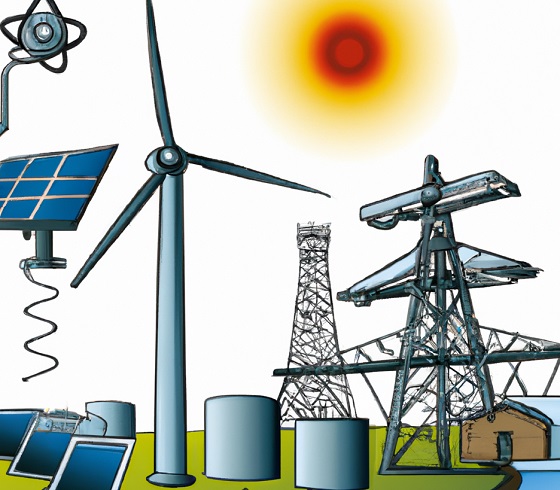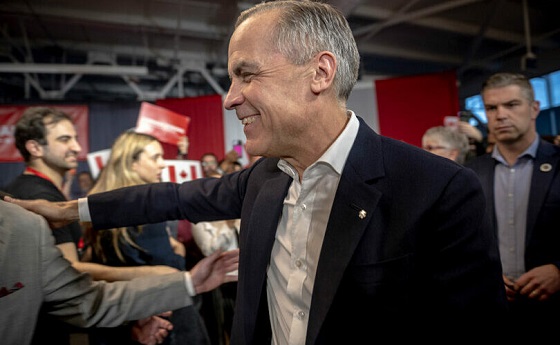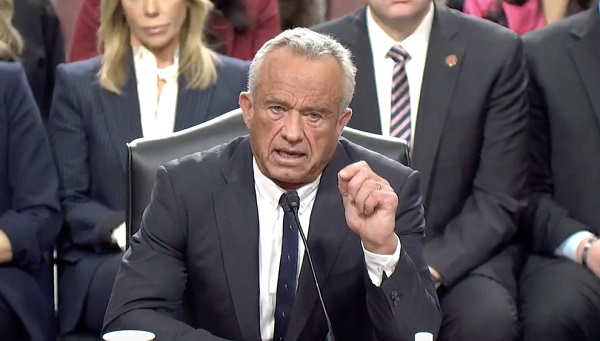Energy
Guilbeault’s Emissions Obsession: Ten Reasons to Call Time Out on Canada’s CO2 Crusade

From the Frontier Centre for Public Policy
Before we collectively devastate our economies, further reduce our birth rates in a misguided attempt to save the planet, squander trillions of dollars, and halt human progress by making energy both scarce and exorbitantly expensive, it’s crucial to remember that human-induced climate change is not a settled fact, but rather a hypothesis largely unsupported by the history of the climate but supported by climate models that have considerable error built into them.
Canadian Environment Minister Steven Guilbeault recently announced a plan requiring the oil and gas industry to cut CO2 emissions by more than one-third from 2019 levels by 2030. This deadline might seem far off, but it also stipulates that at least 20 percent of light-duty vehicle sales must be zero-emission by 2026, a deadline that’s just around the corner. This is all part of Guilbeault’s strategy to achieve the ambitious net-zero emissions target by 2050.
There are at least ten reasons suggesting that this plan is absurd.
- CO2 is Not a Pollutant.
Carbon dioxide is, in fact, a fertilizer crucial for the growth of all vegetation. Higher concentrations of CO2 result in increased crop yields and more productive forests. Healthier forests, in turn, absorb more CO2, providing oxygen in exchange which is essential for the survival of all living organisms including humans.
- CO2 is a Trace Gas
During my extensive career as a university professor, I encountered numerous students eager to support policies that might devastate the livelihoods of thousands of men and women who depend on the oil and gas industry, believing these sacrifices would save the planet. Their near-religious zeal was only matched by their stunning ignorance of basic CO2 facts.
Class surveys I conducted showed that almost one hundred percent of my students were unaware that CO2 is a trace gas, with its atmospheric concentration having varied significantly over centuries and even seasonally. Currently, CO2 represents about 0.04% of the atmospheric gases, or approximately 420 parts per million (ppm). By comparison, nitrogen makes up about 78%, and oxygen around 21%.
The best estimates suggest that human activities contribute roughly 4% of the total annual CO2 emissions (16 ppm). Canada’s share of global emissions is approximately 1.5% (0.24 ppm), essentially a rounding error in the total calculation.
- Why Alberta and Not China?
It is no secret that Guilbeault harbours a special animosity towards Alberta. His energy regulations appear designed to severely impact Alberta’s economy despite the province being a relatively minor player on the global stage. In contrast, China, by far the largest contributor to global CO2 emissions, builds two new coal-powered (dirty) power plants every week and is the primary beneficiary of Canada’s coal exports. Why doesn’t Guilbeault turn his scornful gaze towards the People’s Republic? Even during his visit to China in August 2023 for climate talks, not only did he overlook that country’s appalling environmental track record, to add insult to injury, while there he critiqued Suncor for recommitting to oil sands development, highlighting a troubling policy double standard.
- Watch What They Do, not What They Say
The economic and cultural elites, who incessantly warn of an impending climate catastrophe, seem to contradict their own claims by their extravagant lifestyles. Their opulent residences, frequent use of private jets, and other extravagances reveal a significant disconnect between their rhetoric and their behaviour, suggesting either hypocrisy or a lack of belief in the very crisis they promote.
- Magical Thinking
When they purport to compel the oil and gas industry to adopt new technologies, politicians and policymakers indulge in a particularly delusional form of magical thinking. First, the industry is already one of the most innovative sectors in the economy. Second, these individuals demonstrate a profound ignorance of both climate change and the complex challenges of energy production. As is typical of low-information politicians, they seem to believe that all they need to do to enact change in line with their utopian ideals is to snap their fingers or twitch their collective nose.
- A Multiplier of Human Misery
All the regulations that politicians like Guilbeault introduce with a regularity that rivals the proverbial cuckoo clock have nothing to do with creating new sources of energy or making energy more accessible and affordable. If they were genuinely concerned about their constituents’ welfare, these politicians would incentivize nuclear energy. But they conspicuously do not. These incessant regulations, taxes, and oppressive energy policies serve one purpose: to inflate energy prices so high that middle-class individuals are forced to drive less, reduce their energy use for heating and cooling their homes, and drastically curbing manufacturing. To the extent that such policies persist, they will impose an increasingly devastating economic burden on the poor and the working class.
- Extreme Weather Events
A radical reduction in CO2 emissions will not only lead to a weaker economy and increased poverty, but it will also diminish our capacity to respond to extreme weather conditions, which will occur regardless of the taxation governments impose on human activities.
- The Used-Car Salesman Syndrome
You know you’re being conned when a used car salesperson fails to mention the downsides of the vehicle being considered. The same skepticism and caution should be applied to politicians who tout only the benefits of their proposed policies without discussing the costs. Either they are blissfully unaware of these costs, or they believe they will be insulated from the real-world repercussions of their harmful policies due to their status, wealth, or connections.
- Anti-Human Perspective
While it’s unwise to gratuitously attribute malicious intent to anyone, the evidence suggests that proponents of radical climate change policies operate from what can only be described as an anti-human perspective. They view human beings as liabilities and parasites rather than, as the Judeo-Christian tradition asserts, the valuable assets they truly are.
- A Matter of Debate
Before we collectively devastate our economies, further reduce our birth rates in a misguided attempt to save the planet, squander trillions of dollars, and halt human progress by making energy both scarce and exorbitantly expensive, it’s crucial to remember that human-induced climate change is not a settled fact, but rather a hypothesis largely unsupported by the history of the climate but supported by climate models that have considerable error built into them.
In conclusion, Bjorn Lomborg, the Danish political scientist and founder of the prestigious Copenhagen Consensus Center—an organization renowned for producing some of the most authoritative studies on environmental issues—wisely reminds us that while there are environmental concerns needing attention, it’s questionable whether climate change constitutes an existential crisis that warrants dedicating all our resources at the expense of human life and flourishing.
Pierre Gilbert is Associate Professor Emeritus at Canadian Mennonite University. He writes here for the Frontier Centre for Public Policy.
2025 Federal Election
When it comes to pipelines, Carney’s words flow both ways

 Dan McTeague
Dan McTeague
Well, you’ve got to hand it to Mark Carney. Though he’s only just entered politics — after years of flirting with the idea, while serving on Team Trudeau behind-the-scenes — and despite the fact that he hasn’t been elected to anything yet, he’s become well versed in the ancient political art of speaking out of both sides of his mouth. Like many men seeking high office before him, Carney is happy to say to whoever happens to be in front of him whatever he thinks they want to hear, even if it contradicts what he said to someone else the day before.
Of course, that isn’t so easy to pull off these days. Nowadays pretty much everything a politician says in public is going to pop up on the internet within hours. Which is why it’s been so easy to keep tabs on Carney’s policy flip-flopping.
For just the latest example, last week in Calgary Carney opened his pitch to a sceptical province by saying, “You don’t need to tell me what Alberta is like. I’m from Alberta!” He proclaimed that “Canada has a tremendous opportunity to be the world’s leading energy superpower,” and that “we must invest in our natural strengths and ensure our economic sovereignty!” He promised to “identify projects of national interest,” and fast-track them, while acknowledging that “any major energy project that comes from this great province is going to pass the boundaries of other provinces.”
The implication was that voting for a Carney-led Liberal government would mean a major course correction from the ‘Lost Decade” of Liberal governance, that oil and gas from Alberta should be harnessed to power Canada to prosperity, with pipeline projects (maybe a revived Energy East) spanning every province (presumably over the objections of the government of Quebec, these being projects in the “national interest” and all), and the construction of terminals — of the type for which Trudeau previously said there was no “business case” — enabling us to get Canadian Natural Gas onto tankers bound for Europe and Asia. What else could he have meant by ‘global energy superpower,’ ‘self-sufficiency,’ and the promise to invest in Alberta’s energy infrastructure?
But then Carney found himself being interviewed in Montreal, and his approach was quite different. After his interviewer poked some fun at Carney’s tendency to crib policy proposals from the Conservatives — “do you find Mr. Poilievre has good ideas?” — Carney was asked about his “energy superpower” comments, and he hedged, saying that Canada should work to develop its own resources “if there is social acceptability.” Asked about pipelines specifically, Carney said “We must choose a few projects, a few big projects. Not necessarily pipelines, but maybe pipelines, we’ll see.”
Now, if you think that all of this sounds strangely familiar, you’re not crazy. Carney has been doing this dance since he first stepped out from behind the curtain, saying one thing out west and another back east.
Speaking in B.C. in February he aped a Donald Trump line by saying he wanted Canada to “build, baby, build,” and promised to use “the emergency powers of the federal government to accelerate the major projects that we need in order to build this economy and take on the Americans,” clarifying to CBC that those major projects included pipelines. But then, in a French-language interview, he was asked if he planned to force Quebec to accept a pipeline, and he answered, “I would never impose [a pipeline] on Quebec.”
These examples should be enough to demonstrate that Mark Carney is a Con Man. But who, exactly, is his mark? Is he telling the truth in Quebec, where he’s looking to syphon off support from the Bloc Québécois? Or is he telling the truth in Alberta, where he’d love to snatch a few more urban ridings from the Conservatives?
The answer is that, actually, we’re all his mark. Carney doesn’t really care about Quebec’s sovereignty, or any contentious constitutional question like that. And he certainly has no desire to build pipelines and LNG terminals in order to turn Canada into a global energy superpower. A glance at his long career, as both a public and private sector Net-Zero activist, pressuring both individual corporations and national governments to adopt his environmentalist ideology, will tell you as much.
Once you accept that, you start to notice Carney’s sleight-of-hand on questions of energy and affordability. He’s taking credit for “Axing the Carbon Tax,” when in reality he merely zeroed out part of it, while doubling down on the other half. He’s set it up so that he can bring the Consumer Carbon Tax back whenever he likes, without a vote. Meanwhile, our economy will be slowly strangled by the Industrial Carbon Tax, and our everyday lives will get more expensive as businesses pass the cost down to us.
He remains committed to Bill C-69, the “No More Pipelines Act,” which the Supreme Court said overstepped the federal government’s constitutional authority, which itself shows that his mealy-mouthed talking points on pipelines and energy infrastructure don’t amount to a real commitment to anything. And he still supports the Trudeau government’s emissions caps, which target our Natural Resource Sector, the beating heart of Canada’s economy.
And of course he does, because long ago Mark Carney pledged allegiance to the destructive Net-Zero ideology, and it is that, more than anything else, which is the groundwork for how he will actually govern.
So, whatever you do, don’t buy the con. Mark Carney has spent an entire career, before the start of this campaign, telling us exactly who he is. Don’t let him pull the wool over your eyes now.
Dan McTeague is President of Canadians for Affordable Energy.
Support Dan’s Work to Keep Canadian Energy Affordable!
Canadians for Affordable Energy is run by Dan McTeague, former MP and founder of Gas Wizard. We stand up and fight for more affordable energy.
2025 Federal Election
Mark Carney Wants You to Forget He Clearly Opposes the Development and Export of Canada’s Natural Resources

From Energy Now
At COP26, Mark Carney also said that he thinks “we have both far far too many fossil fuels in the world” and “as much as half of oil reserves, proven oil reserves need to stay in the ground” climate goals.
Mark Carney claims that he supports Canada’s oil and gas industry and wants to see Canada export more of our natural resources. But Carney is yet again lying.
If Carney was sincere, he would immediately commit to the full repeal of the Liberals’ C-69, the ‘No More Pipelines’ Act, C-48, the West Coast Tanker Ban, and the production cap. Instead he doubled down on capping Canadian energy production.
But it’s not just that, Mark Carney has a clear history of opposing Canadian energy and infrastructure projects in favour of his radical anti-energy ideology and his goal of shutting down Canadian energy production.
However, while deliberately fighting against Canadian energy, this high flying hypocrite was having his company, Brookfield Asset Management, invest in some of the largest global pipeline projects in Brazil and the United Arab Emirates.
When asked by Conservative Party Leader Pierre Poilievre at an Industry Committee meeting, if he supported Justin Trudeau’s decision to veto the Northern Gateway pipeline, Mark Carney said “given both environmental and commercial reasons … I think it’s the right decision.”
Then, just six months later at COP26, Mark Carney also said that he thinks “we have both far far too many fossil fuels in the world” and “as much as half of oil reserves, proven oil reserves need to stay in the ground” climate goals.
If this wasn’t enough Mark Carney has now teamed up with Trudeau’s radical anti-energy ministers to finish off Canada’s energy sector, a goal that he has outlined while attending a World Economic Forum event in Davos.
Starting with the radical, self-proclaimed socialist, Steven Guilbeault, who’s history of anti-energy and infrastructure policies is all too familiar to Canadians.
Mark Carney has enabled Steven Guilbeault to do even more damage by promoting him to his Quebec Lieutenant, giving him three new ministerial responsibilities so he can continue his climate crusade against Canadian energy and infrastructure projects.
Canadians remember when Guilbeault said that “I disagree with the [Trans Mountain] pipeline” and that “Canada shouldn’t be investing in new infrastructure for fossil fuels.”
They also remember when he proudly proclaimed that “Our government has made the decision to stop investing in new road infrastructure.” All from a minister who shamed Canadians for owning cars.
Then there is the pipeline hating Jonathan Wilkinson, who Carney appointed as Canada’s Minister of Energy and Natural Resources. Recently, Wilkinson wrote a scathing letter to Canada’s energy leaders for their opposition to the Carney-Trudeau Liberals production cap on Canadian oil and gas.
Despite Canadian industries being subject to unjustified tariffs from the United States, Jonathan Wilkinson recently told reporters that “Everybody’s sort of running around saying, ‘Oh my God, we need a new pipeline, we need a new pipeline.’ The question is, well, why do we need a new pipeline?”
Finally, there is Carney’s new Minister of Environment and Climate Change Terry Duguid. Duguid has doubled down on Mark Carney’s climate radicalism by stating that “a Mark Carney government will maintain the cap on emissions from the production of oil and gas”.
From 2015 to 2021 Carney-Trudeau environmental and anti-industry policies have cancelled over $176 billion in Canadian energy projects, with many more being cancelled afterwards. That means $176 billion worth of jobs and powerful paycheques have been blocked from Canadians so Mark Carney and his Ministers can impose their radical net zero ideology.
-

 International2 days ago
International2 days agoPope Francis’ body on display at the Vatican until Friday
-

 2025 Federal Election21 hours ago
2025 Federal Election21 hours agoCarney’s Hidden Climate Finance Agenda
-

 2025 Federal Election1 day ago
2025 Federal Election1 day agoFormer WEF insider accuses Mark Carney of using fear tactics to usher globalism into Canada
-

 2025 Federal Election13 hours ago
2025 Federal Election13 hours agoThe Anhui Convergence: Chinese United Front Network Surfaces in Australian and Canadian Elections
-

 2025 Federal Election11 hours ago
2025 Federal Election11 hours agoTrump Has Driven Canadians Crazy. This Is How Crazy.
-

 COVID-192 days ago
COVID-192 days agoRFK Jr. Launches Long-Awaited Offensive Against COVID-19 mRNA Shots
-

 Business2 days ago
Business2 days agoTrump considers $5K bonus for moms to increase birthrate
-

 2025 Federal Election2 days ago
2025 Federal Election2 days agoCanada’s press tries to turn the gender debate into a non-issue, pretend it’s not happening


